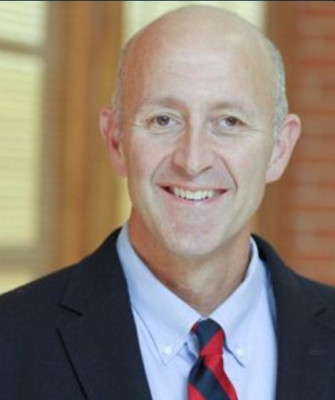Guest Column By Dr. Michael Joyner: Kipchoge’s Run & What Might (or Might Not) Happen Next
by Michael J. Joyner, @DrMJoyner
May 16, 2017
(Editor’s note: Michael Joyner is an anesthesiologist and physiologist who is a human performance expert at the Mayo Clinic. In 1991, he famously published a paper predicting a human could eventually run a marathon as fast at 1:57:58. We are publishing this piece a counterpoint to the column LetsRun.com co-founder Robert Johnson has written: Was Eliud Kipchoge’s 2:00:25 A Monumental Step Forward In Marathoning? No, It Was Not – We Still Are 20+ Years Away From A Legitimate Sub-2 Marathon.
Are you interested in writing a guest column for LetsRun.com? Email us).
I think it is fair to say that I have been thinking seriously about the possibility of a 2-hour marathon for as long as anyone. So, beyond the fact that it was a terrific run, what are my thoughts since Eliud Kipchoge covered the marathon distance in 2:00:25 on May 6th?
One argument is that the whole event was contrived and means nothing. This argument sees the scheme as a brilliant marketing ploy by Nike and the result mostly of drafting in the slipstream of the pace car and “peloton” of pace setters. A more optimistic view is that there are valuable lessons that could be applied to “real” races and result in substantial improvements in a real ratifiable race. However, before I go on I want to acknowledge up front that I have done some consulting for Nike, but not on this project and also that Brad Wilkins, one of the Nike scientists leading the project, worked with me in the 2000s.
About the car….. People at the race tell me that the car was 5-6 meters in front of the runners and that the green line was in fact there to keep the pack from getting too close. Beyond that, Kipchoge was at least a few meters more behind the lead runner. So he was perhaps 8-9 meters behind the car most of the race. There are calculations floating around about the effects of any slipstream from the car, but it should be pretty easy for some enterprising exercise science and engineering graduate students to do a real world test. It should also be possible to look at the video and get an estimate of the average distance Kipchoge was behind the car. I look forward to this data!
The Peloton of Runners….. My personal bias is that this made a big difference for two reasons: First, the potential energy saving effects of drafting which have been known many years and could be about 6.5% at speeds similar to those Kipchoge was running. Second, the psychological burden of establishing a pace and rhythm seemed clearly reduced by the pacing. Of note Paula Radcliffe’s 2:15:25 in a mixed race was more or less paced and is a little over 1:30 faster than the fastest time in a women’s only race. How much did this help? Who knows, and while getting a pace line going for 26 miles is unlikely in a real race, it should be possible to generate a prize money scheme to get a pace-line-like pack of runners to 20 miles very fast. With a bigger field and with races designed for a fast time, the odds of someone having the sort of days that Ron Clarke had in 1965 or doing what Bob Beamon did in 1968 increase.
 Dr. Joyner via @DrMJoyner
Dr. Joyner via @DrMJoyner
The Course & Temp….. A course with a limited number of right angle turns can’t hurt. This should be doable and if some magnate (I keep thinking Richard Branson) wants to set up an invitational race and generate the “fastest” field ever, finding a course like the one at Monza should not be a problem. General Motors has a 4.5-mile oval at the Yuma Proving Grounds and it should be possible to run this hypothetical invitational race at a place like that, at twilight on a predictably cool and dry winter evening in the desert. How fast would Kipchoge have gone if it were 5 degrees cooler and not humid?
The Shoes….. Who knows how lab values showing improved running economy with the shoes translate to real performances. However, we do know that tuned tracks can improve performance and while the biomechanics are complex, some of the ideas behind tuned tracks were essentially reversed and engineered into the shoes. So for those who think the shoes had no effect, the question is how skeptical are you about tuned tracks?
The Drink…. I did some back of the envelope calculations and Kipchoge was likely burning about 18 calories per minute during his run with about 2/3rds of that energy coming from carbohydrates. That means he used about 360 gms of glucose over the 2 hours. If this calculation is in the ball park, then all he needed from the drinks was perhaps 50 gms of glucose and he could have gotten that via some iced tea with table sugar!
The Nike Infomercial vs. Give Nike a Break ….. Read LetsRun on a regular basis and the real and imagined sins of Nike are in full view and discussed regularly with gusto. The problems with the streaming and lack of real time stats on the screen must have bothered even casual viewers. However, Nike took a big public risk and this whole effort could have gone very south, very fast. If Kipchoge had faded the second half of the race, or if he had cramped at mile 23, imagine the PR disaster for Nike. Say what you like, but streaming this live did take some corporate cojones. Perhaps the ghost of Bill Bowerman lives.
1991 Revisited…. In my original paper I pointed out that compared to things like maximal oxygen uptake and the lactate threshold little was known about running economy and fatigue at very high speeds. I would say the May 6th effort validated my early take on those knowledge gaps and showed what might be possible if they were managed to the maximum extent possible. I would also argue that moving forward, a race that featured the right runners (and a lot of them), on the right course, on the right day, with the right prize money scheme could lead to something around 2:01:30 or perhaps a bit faster soon. If such a race can happen on a regular basis then, as I have been saying for the last few years, the fun will begin. If that does happen then maybe, just maybe, Robert Johnson will still be contributing to his retirement plan when someone “breaks 2” in a real race.
Michael Joyner, is a researcher at the Mayo Clinic, these views are his own. You can follow him on Twitter @DrMJoyner
More: Was Eliud Kipchoge’s 2:00:25 A Monumental Step Forward In Marathoning? No, It Was Not – We Still Are 20+ Years Away From A Legitimate Sub-2 Marathon.
Talk about the two columns on our fan forum / messageboard. MB: Dr. Michael Joyner and LetsRun’s Robert Johnson share their thoughts on what Eliud Kipchoge’s 2:00:25 means.
Note from LetsRun.com’s Weldon Johnson: After reading this piece and Robert Johnson’s counter piece, I don’t think they are crazily different. Robert seems to think Kipchoge can run 2:02:15 or so under current Berlin Marathon conditions. Joyner thinks someone can run 2:01:30 or so on the right course, with a ton of competition, on the right day (different conditions than Robert is proposing). They have slightly different starting points of where we are at, and then presumably differ on how much we can improve going forward.
